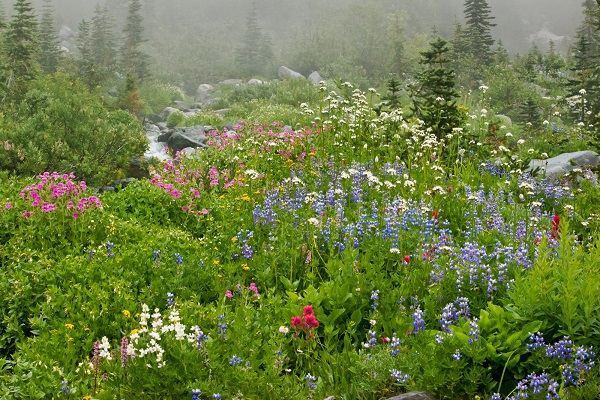
By Conor Risch, guest writer
This photograph from Rob Badger and Nita Winter’s long-term project “Beauty and the Beast: Wildflowers and Climate Change,” reminded me immediately of John Muir’s account of the wildflowers ringing Mount Rainier. In his 1898 essay for The Atlantic Monthly, “Wild Parks and Forest Reservations of the West,” Muir marveled at the “the richest subalpine garden I ever found, a perfect floral elysium.” The “zone of the loveliest flowers, fifty miles in circuit and nearly two miles wide,” Muir wrote, appeared as if Nature were “trying to see how many of her darlings she could get together in one mountain wreath.”
In this image from Mount Rainier National Park, the thick green vegetation and the bright colors of the diverse flower species hint at a vast and thriving landscape. The mist in the background heightens the sense that the field stretches out as far as the eye can see, and beyond. While the boulder-lined creek flowing heavily brings Rainier’s glaciers and the importance of its yearly snowpack to mind.
Since 1998, Badger and Winter have documented spring wildflowers on public lands throughout the United States, creating a body of work that celebrates the beauty of the blooms while also addressing the threats they face from climate change and invasive species. Muir was arguing in his essay that Rainier be made a National Park (which it was, shortly thereafter), that its forests and wildflowers needed to be protected from exploitation. What Muir didn’t know was that unfettered exploitation elsewhere would imperil the natural blooms at Rainier and in other preserved spaces. Yet that is exactly what’s happening, as the caption for Badger and Winter’s image image tells us. The authors point out the Albino Lupine and suggest that its bloom may signal a climate-related shift in the ecosystem. We can’t disconnect one place from another, the image suggests. We can’t be selective in our stewardship of our natural world.
A traveling exhibition of Beauty and the Beast is currently touring in California, and has reached an audience of more than 25,000 people. The show encourages viewers to take action in their lives to reduce carbon emissions and to support environmental organizations that are working toward a sustainable future. The photographers also plan to release a book of the project in early 2019.
Click to view Nita Winter’s profile.
Click to view Rob Badger’s profile.
Conor Risch is a Seattle-based writer and senior editor of Photo District News (PDN). Follow him on Twitter @c_risch.